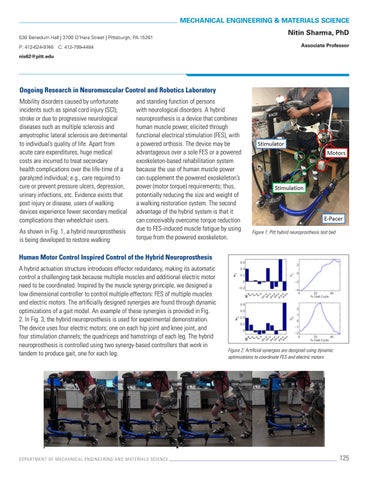MECHANICAL ENGINEERING & MATERIALS SCIENCE
Nitin Sharma, PhD
538 Benedum Hall | 3700 O’Hara Street | Pittsburgh, PA 15261
Associate Professor
P: 412-624-9746 C: 412-799-4484 nis62@pitt.edu
Ongoing Research in Neuromuscular Control and Robotics Laboratory Mobility disorders caused by unfortunate incidents such as spinal cord injury (SCI), stroke or due to progressive neurological diseases such as multiple sclerosis and amyotrophic lateral sclerosis are detrimental to individual’s quality of life. Apart from acute care expenditures, huge medical costs are incurred to treat secondary health complications over the life-time of a paralyzed individual; e.g., care required to cure or prevent pressure ulcers, depression, urinary infections, etc. Evidence exists that post injury or disease, users of walking devices experience fewer secondary medical complications than wheelchair users. As shown in Fig. 1, a hybrid neuroprosthesis is being developed to restore walking
and standing function of persons with neurological disorders. A hybrid neuroprosthesis is a device that combines human muscle power, elicited through functional electrical stimulation (FES), with a powered orthosis. The device may be advantageous over a sole FES or a powered exoskeleton-based rehabilitation system because the use of human muscle power can supplement the powered exoskeleton’s power (motor torque) requirements; thus, potentially reducing the size and weight of a walking restoration system. The second advantage of the hybrid system is that it can conceivably overcome torque reduction due to FES-induced muscle fatigue by using torque from the powered exoskeleton.
Figure 1: Pitt hybrid neuroprosthesis test bed
Human Motor Control Inspired Control of the Hybrid Neuroprosthesis A hybrid actuation structure introduces effector redundancy, making its automatic control a challenging task because multiple muscles and additional electric motor need to be coordinated. Inspired by the muscle synergy principle, we designed a low dimensional controller to control multiple effectors: FES of multiple muscles and electric motors. The artificially designed synergies are found through dynamic optimizations of a gait model. An example of these synergies is provided in Fig. 2. In Fig. 3, the hybrid neuroprosthesis is used for experimental demonstration. The device uses four electric motors; one on each hip joint and knee joint, and four stimulation channels; the quadriceps and hamstrings of each leg. The hybrid neuroprosthesis is controlled using two synergy-based controllers that work in tandem to produce gait, one for each leg.
DEPARTMENT OF MECHANICAL ENGINEERING AND MATERIALS SCIENCE
Figure 2: Artificial synergies are designed using dynamic optimizations to coordinate FES and electric motors
125
